Physical Address
304 North Cardinal St.
Dorchester Center, MA 02124
Allows visualization of osseous anatomy and pathology, bone contours, and joint alignment
Is recommended for any primary evaluation of osseous wrist pathologic processes such as fractures, dislocations or malalignment, infection, and bone tumors ( eTable 13-1 ; eFigs. 13-1 to 13-5 )
| Projections | Main Visualized Anatomy and Pathology |
|---|---|
| Posteroanterior * (dorsopalmar view) | Overview of carpal bones and their relationships |
| The ECU groove should be radial to the midportion of the ulnar styloid when elbow is at shoulder height ( eFig. 13-1 ) | Ulnar variance (most accurate when elbow is at shoulder height) |
| Ulnar deviated posteroanterior * (scaphoid view) ( eFig. 13-2 ) | Scaphoid fractures |
| Displacement of fractures | |
| Scapholunate dissociation | |
| Radiolunate (radiocarpal), capitolunate (midcarpal) motion when compared with the neutral and radial deviation views | |
| Widens scapholunate joint and closes the lunotriquetral joint | |
| Semipronated oblique * ( eFig. 13-3 ) | Detects scaphoid tuberosity and waist fractures |
| Evaluates the scaphotrapezial, trapeziotrapezoidal, and capitolunate joints, and often the carpometacarpal and scaphotrapezoidal joints | |
| Lateral * The volar surface of the pisiform should lie between the volar surfaces of the distal tuberosity of the scaphoid and capitate. This is called the scaphopisocapitate (SPC) relationship ( eFig. 13-4 ) |
Palmar or dorsal carpal displacement, angulation of fracture fragments |
| Dislocations of the distal radius and ulna | |
| Dorsal and ventral chip fractures or calcifications | |
| Scapholunate, radiolunate, capitolunate, radioscaphoid, and intercarpal angles | |
| Anteroposterior view (palmodorsal, no pronation). This is useful when pronation is impossible | Evaluates scapholunate and lunotriquetral joints; often better than with posteroanterior view |
| Lateral extension | Demonstrates carpus extension at the radiocarpal and midcarpal joints |
| Lateral flexion | Demonstrates flexion of the carpus at the radiocarpal and midcarpal joints |
| Posteroanterior radial deviation ( eFig. 13-5A ) | Determines motion between the forearm and the carpus and between the proximal and distal carpal rows |
| Widens the lunotriquetral joint and closes the scapholunate joint | |
| Anteroposterior radial deviation | Widens the lunotriquetral joint and closes the scapholunate joint |
| Determines midcarpal, intercarpal, and radiocarpal motion when patient cannot pronate | |
| Anteroposterior ulnar deviation | Determines radial/ulnar motion at the midcarpal and radiocarpal joints |
| Widens the scapholunate joint and closes the lunotriquetral joint | |
| Another view for scaphoid fractures | |
| PA-distal tilt from elbow toward fingers (capitate waist view) | Evaluates the capitate for fractures |
| Semisupinated oblique (pisiform or off-lateral view) | Evaluates pisiform, pisotriquetral joint, palmar aspect of the triquetrum, and palmar ulnar surface of the hamate |
| Clenched fist without wrist flexion or extension | Evaluates scapholunate diastasis (better to evaluate with anteroposterior than posteroanterior clenched fist view) |
| Lateral with radial deviation and thumb abducted | Evaluates hamate hook |
| Carpal tunnel view | Evaluates hamate hook |
| Evaluates the volar surfaces of the trapezium, pisiform, and triquetrum | |
| Assesses for calcifications or ossifications in the carpal tunnel |
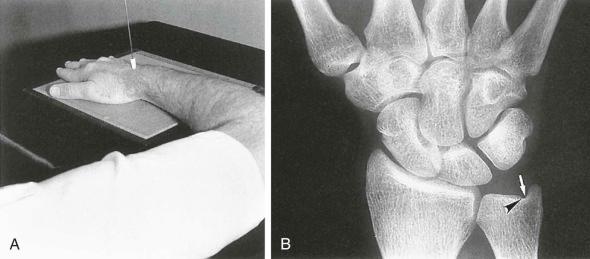
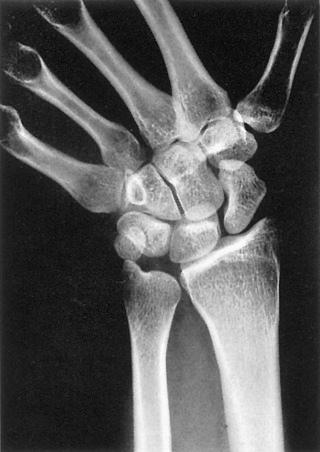
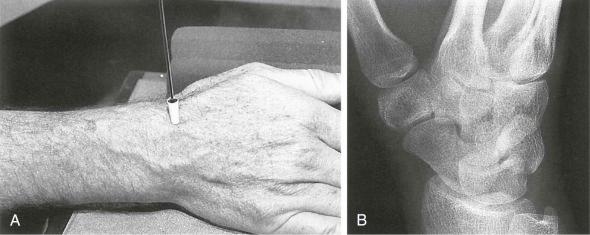
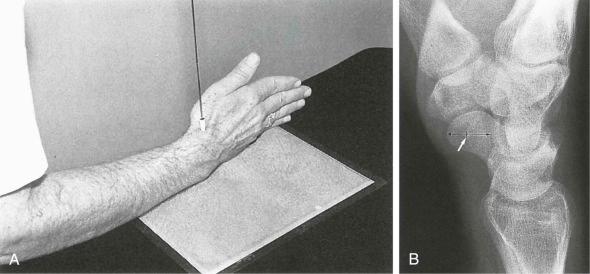
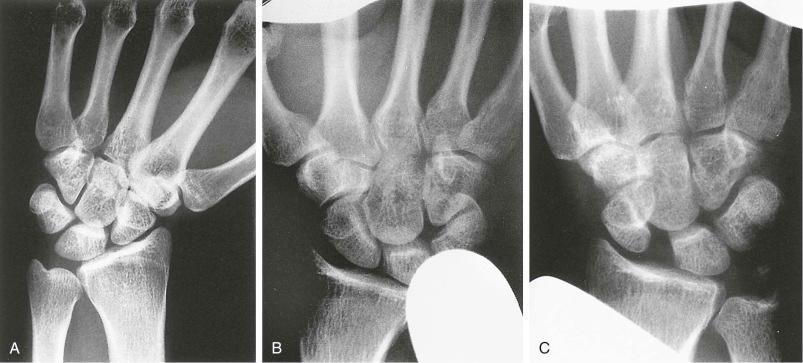
Radiographic positioning for fluoroscopy for instability is described in eTable 13-2 ( eFig. 13-6 ). (See also eFigs. 13-1, 13-2, and 13-5 .)
| Projection | Maneuver | Main Visualized Anatomy |
|---|---|---|
| Posteroanterior (palmar-dorsal view) | Neutral, passive ulnar, and radial, deviation of the carpus ( eFigs. 13-1B, 13-2, and 13-5A ) | Evaluates radiocarpal and midcarpal motionEvaluates for scapholunate widening, especially on ulnar deviation |
| Posteroanterior | Apply ulnar and radial stress to carpus ( eFig. 13-5BC ) | Assesses laxity of radiocarpal ligaments |
| Posteroanterior | Radial deviation, profile lunotriquetral joint | Lunotriquetral joint |
| Posteroanterior | Profile distal radioulnar joint | Distal radioulnar joint, base of ulnar styloid |
| Oblique and neutral lateral | Turn wrist and hand keeping dorsum of metacarpals and radius in a straight line | Radius, lunate, capitate alignment, and scaphotrapeziotrapezoid relationship |
| Neutral lateral | Passive flexion and extension | Intercarpal and radiocarpal motion |
| Neutral lateral | Ulnar and radial deviation to carpus | Lunate motion (lunate should tilt dorsal with ulnar and volar with radial deviation) |
| Neutral lateral | Ventral and dorsal stress to carpus; capitolunate instability patterns (CLIP maneuver) ( eFig. 13-6 ) | Lunate and capitate alignment |
| Anteroposterior | Ulnar, neutral, and radial deviation, profile scapholunate joint | Assesses scapholunate joint |
| Anteroposterior | Clenched fist, profile scapholunate joint | Assesses scapholunate joint |
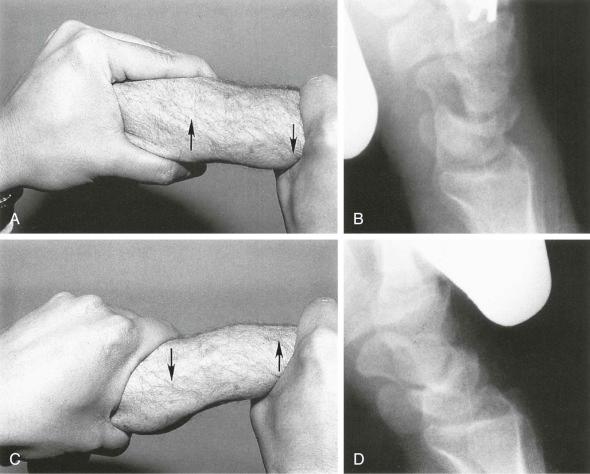
Real-time imaging; captures transient abnormalities that occur with motion
Is inexpensive
Cannot evaluate ligaments directly
Cannot evaluate tendons, muscles, and nerves
Is insensitive to early infection or intraosseous or nondisplaced fractures
Uses ionizing radiation
Intraarticular injection of iodine contrast agent allows evaluation of disrupted intrinsic and capsular ligaments ( eFig. 13-7 ).
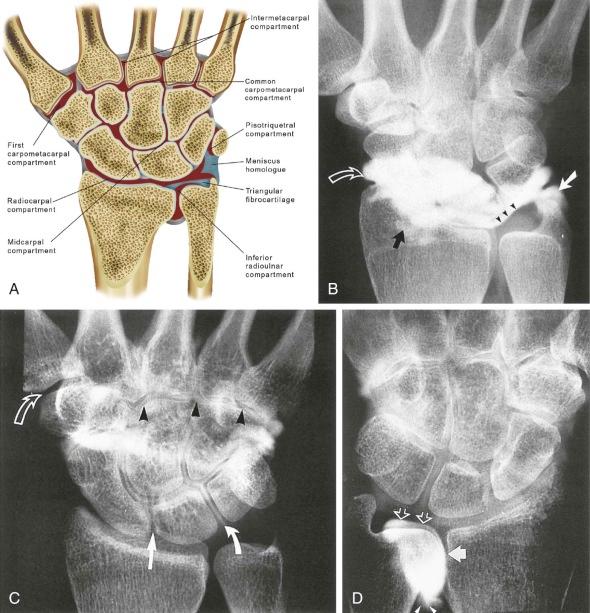
Main indication: assessment of suspected triangular fibrocartilage (TFC) and triangular fibrocartilaginous complex (TFCC) tears, scapholunate ligament (SL) tears, and lunotriquetral (LT) tears
Is indicated when there is a contraindication to MRI, patient is claustrophobic, or when the results of MRI are indeterminate regarding SL, LT, or TFC tears
Can be performed without delay
Can use single-, double-, or triple-compartment injection with diluted iodinated contrast medium (dilution)
Is inexpensive and quick
Has no artifacts from metal hardware
Can identify communicating/noncommunicating defects
Can easily assess opposite side
Cannot evaluate ligaments directly
Cannot evaluate tendons, muscles, and nerves
Is insensitive to early infection or intraosseous or nondisplaced fractures
Uses ionizing radiation
Provides multiplanar direct or reconstructed images and allows surface rendering to create 3D images
Evaluates healing, nonunion of fractures, alignment after reduction of fracture fragments and those not seen on conventional radiography, and osteolysis
Allows evaluation of gross soft tissue pathologic processes
Evaluates bone tumor matrix (cartilage vs. osteoid)
Evaluates suspected abnormality found on conventional radiography, especially in areas of complex anatomy such as the carpometacarpal joints
Shows high resolution of osseous structures
Has multiplanar and surface-rendering capability
Is more readily available than MRI
Is less expensive than MRI
Is quick compared with MRI
Can easily and quickly perform additional positions so as to stress the distal radioulnar joint (DRUJ)
Provides limited evaluation of soft tissues compared with MRI
Is expensive compared with conventional radiography
Uses ionizing radiation
May have beam-hardening artifact especially from metal
The patient's arm should be placed prone and extended above the head. A pillow can be placed under the upper chest for improved patient comfort. Suggested parameters to use (based on Siemens machines) are listed in eTable 13-3 . When metal or a cast is present, then the parameters are adjusted to obtain the best possible image with the least amount of beam-hardening artifact. This includes changing the kV, pitch, and kernel and using an extended CT scale.
| Without Metal or Cast | With Metal or Cast | |
|---|---|---|
| Slice thickness (mm) | 0.75 | 0.75 |
| Detector collimation (mm) | 0.75 | 0.75 |
| Kernel | B70 (bone) | B45 |
| Pitch | 9 | 6 |
| Reconstruction (mm) | 0.7 | 0.7 |
| kV/Effective mA/Rotation time (sec) | 120/300/1.0 | 140/300/1.0 |
Direct scanning is performed axially ( eFig. 13-8 ) in the craniocaudal direction starting from the metacarpal bases and ending 2 cm proximal to the distal radius. If a fracture is present, then the extent of the fracture is included.

Multiplanar reformatted (MPR) images are often very useful to obtain coronal and sagittal planes as well as an oblique sagittal plane through the long axis of the scaphoid. These images are obtained with 1.0-mm-thick slices × 1.0-mm interval gap.
Several authors have reported that CT arthrography can be advantageous. Currently, it is used to evaluate articular cartilage as well as SL, LT, and TFC tears. At our institution, CT wrist arthrography is not routinely performed.
Assesses soft tissue anatomy and pathology, including the intrinsic and extrinsic ligaments, neurovascular structures, and osseous pathology
Is multiplanar and nonionizing
Is expensive
Has long imaging time
May have artifacts from metal, motion, pulsation, chemical shift, or fat saturation
Can be difficult for claustrophobic patients in closed magnets
Suggested parameters with a 1.5-T magnet include the arm placed prone and over the patient's head. The key is patient comfort; therefore, the elbow may be slightly flexed and the palm may be supine, prone, or lateral. Pillows can be placed under the chest to flex the shoulder slightly forward ( eTables 13-4 and 13-5 ).
| Coil | Phased array, flex coil |
| Slice thickness | Coronal, 3 mm; axial, 4 mm; sagittal, 4 mm |
| Matrix | 256 |
| Field of view (cm) | 12 |
| Imaging Plane | Pulse Sequence |
|---|---|
| Coronal | T1-, T2-weighted fat-saturated fast spin-echo |
| Axial | T1-, T2-weighted fat-saturated fast spin-echo |
| Sagittal | T2-weighted fast spin-echo |
| Optional Planes | |
| Coronal (1-mm slice, field of view 13 cm) | 3D gradient-echo |
| Sagittal | T1-weighted |
1.5-tesla as compared to 3.0-tesla MRI:
Until recently, 1.5-tesla MRI has been used as the reference standard for most clinical applications, including evaluation of the complex wrist anatomy. However, numerous limitations in visualization and assessment of small ligaments and tendons within the wrist have been reported with traditional 1.5-tesla MRI.
3.0-Tesla MRI improves signal-to-noise ratio (SNR) by approximately twofold when compared to conventional 1.5-tesla MRI. In addition, 3.0-tesla MRI increases spatial resolution by utilizing smaller slice thickness, larger matrix size and smaller field of view.
The TFCC, dorsal, and volar extrinsic and the intrinsic ligaments along with the flexor and extensor tendons compose the support network of the wrist. 3.0-Tesla MR images of these complex wrist structures, including the TFCC, intrinsic and extrinsic radiocarpal ligaments, and flexor and extensor tendons, are depicted in eFigure 13-9 .
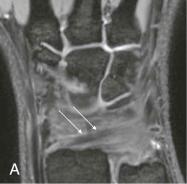
The fine components of the TFCC are easily appreciated on high-resolution 3.0-tesla MR images. Likewise, the individual bands of intrinsic ligaments are clearly visualized because of central positioning within the wrist coil. In addition, the individual slips and the intracompartmental intertendinous separations of the flexor and extensor tendons inseparable at lower field strengths are well seen on the 3.0-tesla MRI because of improved contrast resolution.
The high SNR and high spatial resolution of 3.0-tesla MR images allow for better visualization of the volar extrinsic ligaments, even in the absence of contrast-enhanced MR arthrography. With 3.0-tesla MRI, the dorsal extrinsic ligament complex appears as thickening of the dorsal wrist capsule below the extensor compartment tendons.
Allows for distention of the joint to best assess the TFC and intrinsic ligaments
At our institution, a few fluoroscopic images are taken before injection ( eTable 13-6 ) for comparison with the postinjection fluoroscopic images. This includes profiling the SL, LT, and DRUJ with the wrist prone and the SL with the wrist supine with a clenched fist.
| Imaging Plane | Pulse Sequence |
|---|---|
| Coronal (3 mm) | T1-, T2-weighted, fat-saturated (FS) |
| Coronal (1 mm) | 3D fast low-angle shot (FLASH) |
| Axial | T1-, T2-weighted fat-saturated |
| Sagittal | T2-weighted |
The first step is to inject the radiocarpal joint under fluoroscopic guidance ( eFig. 13-10 ), and the second step is to take the patient to the MR scanner for multisequence and multiplanar imaging. A repeatedly successful and suggested technique is to use a dorsal approach to touch the scaphoid proximal to the ridge at the scaphoid waist and then advance the needle into the radioscaphoid joint.
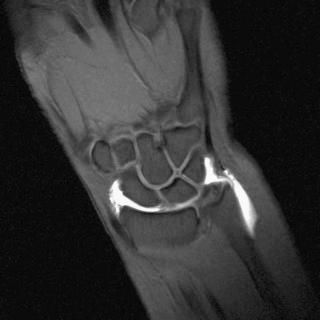
Using the dorsal approach to the radioscaphoid joint requires placing the wrist prone and in ulnar deviation to increase the intraarticular area of the radioscaphoid joint. First, under fluoroscopy, the skin surface is marked overlying the desired point of needle tip insertion, which is just proximal to the scaphoid ridge at its waist at the radial margin of the bone. The area should then be prepped and draped in sterile fashion. Subcutaneous anesthesia is recommended, and deeper anesthesia is optional. A 23- or 25-gauge, 1-inch needle is used to touch the scaphoid at the desired point. Then, the needle is directed toward the radioscaphoid joint and advanced 2 to 3 mm into the joint.
Sometimes the needle may be advanced too far volarly if it slips along the radial side of the scaphoid. If this occurs, then the needle must be retracted until it is in the joint.
Once intraarticular needle tip position is confirmed with contrast agent alone or mixed with the diluted 1 : 200 gadolinium, the joint is distended. The volume often is less than 5 mL, unless there are communicating defects in the intrinsic ligaments or the TFC. After the injection, the same preinjection fluoroscopic images are taken. Then the patient is taken to the scanner for imaging within 30 minutes.
Can assess TFC, SL, and LT ligament tears
Shows better distention of the joint capsule to detect extrinsic ligament pathology
Is invasive compared with routine MRI
Requires extra time and labor minutes per procedure
Must coordinate availability of fluoroscopic unit with that of MR scanner
Uses ionizing radiation
Has potential for infection and allergy to anesthetic or contrast agent
Use of extra-articular injection of contrast medium can make interpretation difficult
Has risk of air bubbles being misinterpreted as loose bodies
Is based on bulk flow and diffusion of intravascular contrast medium into the joint. The greater the amount of synovial fluid and inflammation in the joint, the greater the enhancement.
Consider when evaluating small joints, such as the wrist or after surgery
Allows detailed assessment of intraarticular and extra-articular disease of a joint. Questionable pathologic processes will enhance.
Because indirect MR arthrography is not performed at our institution, more detail can be obtained from the article by Bergin and Schweitzer.
Become a Clinical Tree membership for Full access and enjoy Unlimited articles
If you are a member. Log in here